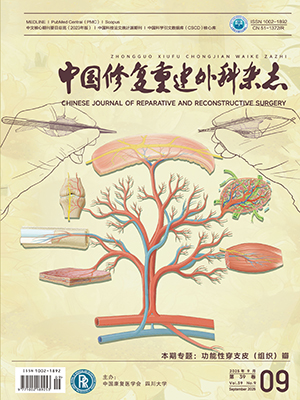| 1. |
Howells NR, Brunton LR, Robinson J, et al. Acute knee dislocation: an evidence based approach to the management of the multiligament injured knee. Injury, 2011, 42(11): 1198-1204.
|
| 2. |
McKee L, Ibrahim MS, Lawrence T, et al. Current concepts in acute knee dislocation. The missed diagnosis? Open Orthop J, 2014, 8(Suppl 1: M5): 162-167.
|
| 3. |
Lachman JR, Rehman S, Pipitone PS. Traumatic knee dislocations: evaluation, management, and surgical treatment. Orthop Clin North Am, 2015, 46(4): 479-493.
|
| 4. |
Krackow KA, Thomas SC, Jones LC. Ligament-tendon fixation: analysis of a new stitch and comparison with standard techniques. Orthopedics, 1988, 11(6): 909-917.
|
| 5. |
Fanelli GC, Orcutt DR, Edson CJ. The multiple-ligament injured knee: evaluation, treatment, and results. Arthroscopy, 2005, 21(4): 471-486.
|
| 6. |
Wong CH, Tan JL, Chang HC, et al. Knee dislocations-a retrospective study comparing operative versus closed immobilization treatment outcomes. Knee Surg Sports Traumatol Arthrosc, 2004, 12(6): 540-544.
|
| 7. |
Levy BA, Dajani KA, Whelan DB, et al. Decision making in the multiligament-injured knee: an evidence-based systematic review. Arthroscopy, 2009, 25(4): 430-438.
|
| 8. |
Peskun CJ, Whelan DB. Outcomes of operative and nonoperative treatment of multiligament knee injuries: an evidence-based review. Sports Med Arthrosc, 2011, 19(2): 167-173.
|
| 9. |
Harner CD, Waltrip RL, Bennett CH, et al. Surgical management of knee dislocations. J Bone Joint Surg (Am), 2004, 86-A(2): 262-273.
|
| 10. |
Fanelli GC. Multiple ligament-injured (dislocated) knee. Sports Med Arthrosc, 2011, 19(2): 81.
|
| 11. |
Khakha RS, Day AC, Gibbs J, et al. Acute surgical management of traumatic knee dislocations—Average follow-up of 10 years. Knee, 2016, 23(2): 267-275.
|
| 12. |
Wilson SM, Mehta N, Do HT, et al. Epidemiology of multiligament knee reconstruction. Clin Orthop Relat Res, 2014, 472(9): 2603-2608.
|
| 13. |
Owens BD, Neault M, Benson E, et al. Primary repair of knee dislocations: results in 25 patients (28 knees) at a mean follow-up of four years. J Orthop Trauma, 2007, 21(2): 92-96.
|
| 14. |
Bin SI, Nam TS. Surgical outcome of 2-stage management of multiple knee ligament injuries after knee dislocation. Arthroscopy, 2007, 23(10): 1066-1072.
|
| 15. |
Kohl S, Stock A, Ahmad SS, et al. Dynamic intraligamentary stabilization and primary repair: a new concept for the treatment of knee dislocation. Injury, 2015, 46(4): 724-728.
|
| 16. |
陈平泉, 朱振康, 王胜. 膝前、后交叉韧带与内侧副韧带损伤的一期修复重建. 中国修复重建外科杂志, 2012, 26(6): 675-678.
|
| 17. |
Engebretsen L, Risberg MA, Robertson B, et al. Outcome after knee dislocations: a 2-9 years follow-up of 85 consecutive patients. Knee Surg Sports Traumatol Arthrosc, 2009, 17(9): 1013-1026.
|
| 18. |
Sillanpää PJ, Kannus P, Niemi ST, et al. Incidence of knee dislocation and concomitant vascular injury requiring surgery: a nationwide study. J Trauma Acute Care Surg, 2014, 76(3): 715-719.
|
| 19. |
Mook WR, Ligh CA, Moorman CT 3rd, et al. Nerve injury complicating multiligament knee injury: current concepts and treatment algorithm. J Am Acad Orthop Sur, 2013, 21(6): 343-354.
|
| 20. |
Edson CJ, Fanelli GC, Beck JD. Rehabilitation after multiple-ligament reconstruction of the knee. Sports Med Arthrosc, 2011, 19(2): 162-166.
|
| 21. |
Chhabra A, Cha PS, Rihn JA, et al. Surgical management of knee dislocations. Surgical technique. J Bone Joint Surg (Am), 2005, 87 Suppl 1(Pt 1): 1-21.
|




